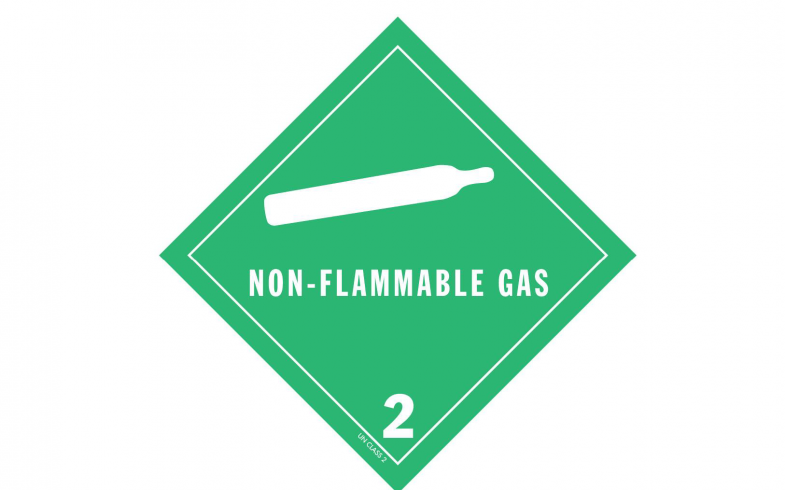| CAS Number: 7440-59-7 | |||||||||||||||||||||||||||||||
| UN Number: UN 1046 | |||||||||||||||||||||||||||||||
| DOT Shipping Name: Helium, Compressed | |||||||||||||||||||||||||||||||
| DOT Classification: 2.2 (Non-Flammable Gas) | |||||||||||||||||||||||||||||||
| Label: NON-COMBUSTIBLE, NON-POISONOUS GAS |

Helium in a gaseous state of aggregation is an inert gas without color, odor and taste. Helium is neither toxic nor flammable, not explosive, but at high concentrations in the air it causes a state of oxygen deficiency and suffocation.
The bowels and atmosphere of our planet are poor in Helium. According to modern estimates, 76% of the cosmic mass falls on Hydrogen and 23% on Helium, and only one percent remains for all other elements. Thus, the world’s matter can be called Hydrogen – Helium. These two elements dominate in stars, planetary nebulae and interstellar gas. The reaction of Helium fusion is the basis of the energetic activity of stars, their glow. Consequently, the synthesis of Helium can be considered the forefather of all reactions in nature, the primary cause of life, light, heat and meteorological phenomena on Earth.
There is no second such substance in nature. It is the best conductor of electricity among gases and the second, after Hydrogen, conductor of heat. Its heat capacity is very high, while its viscosity, on the contrary, is low. In 1938, the Soviet physicist Pyotr Leonidovich Kapitsa discovered the phenomenon of superfluidity of liquid Helium-II.
An interesting fact.
Helium is an unusual element, its history is somewhat mysterious and incomprehensible. It (its spectral line) was found in the atmosphere of the Sun 13 years earlier than on Earth (in 1868) when observing a solar eclipse and studying the chromosphere of the Sun by the French astronomer Pierre Jules César Janssen and the English astronomer Joseph Norman Lockyer. The unknown element was named Helium from the Greek word ἥλιος – “Sun”. This new unknown element was initially thought to be metal. It was only in 1895 that William Ramsay isolated Helium from a mixture of gases; it turned out to be chemically inert, like Argon. Shortly thereafter, Joseph Lockyer, Carl David Tolme Runge (German: Carl David Tolmé Runge) and Louis Paschen (German: Louis Karl Heinrich Friedrich Paschen) announced that Helium is composed of a mixture of two gases – Orthohelium and Parahelium. One of them gives the yellow line of the spectrum, the other green. They proposed to call this second gas Asterium from the Greek – “Star”. Together with Morris William Travers, William Ramsay verified this statement and proved it to be wrong, since the color of the Helium line depends on the gas pressure.

Scopes of Helium:
- metallurgy – as an inert shielding gas for smelting pure metals;
- welding production – inert medium in arc welding;
- food industry – as packing gas for food storage;
- as a refrigerant for ultra-low temperatures;
- for gas-filled air vessels and meteorological probes, as well as balloons in the entertainment industry;
- in deep-sea diving breathing mixes;
- advertising – for filling gas discharge tubes;
- as a carrier gas in gas chromatography;
- as a component of the working fluid in helium-neon lasers.

INGAS LLC produces Helium of various brands (purity) by the method of low-temperature rectification.

| Formula: He | ||||
| General Description: monoatomic, non-toxic, chemically inert gas, odorless, colorless and tasteless | ||||
| Atomic (molar) mass: 4.0026 g/mol | ||||
| Properties of the chemical element | 0°С (273.15°K, 32℉) & 760 mm Hg (1 atm (physical), 1.033 at (technical), 101.325 кN/м², 101.325 кPа, 14.7 psia, 0 psig, 30 in Hg, 760 torr) | 15°С (288.15°K, 59℉) & 760 mm Hg (1 атм (physical), 1.033 at (technical), 101.325 кN/м², 101.325 кPа, 14.7 psia, 0 psig, 30 in Hg, 760 torr) | 20°С (293.15°K, 68℉) & 760 mm Hg (1 atm (physical), 1.033 at (technical), 101.325 кН/м², 101.325 кPа, 14.7 psia, 0 psig, 30 in Hg, 760 torr) | 15°С (288.15°К, 59℉) & 1 bar (0.987 atm (physical), 1.02 at (technical), 100 кN/м², 100 кPа, 14.5 psia, 0 psig, 29.53 in Hg, 750.062 torr) |
| Density at various temperatures and pressures: | 0.1785 kg/m³ | 0.1692 kg/m³ | 0.1664 kg/m³ | 0.1671 kg/m³ |
| Specific volume at various temperatures and pressures: | 5.6022 m³/kg | 5.9095 m³/kg | 6.0110 m³/kg | 5.9853 m³/kg |

| No | Names of gas and controlled impurities | Formula of an element or chemical compounds | Gas purity and content of its controlled impurities (vol.%, ppmv) | ||||
| Brand 4.0 | Brand 4.5 | Brand 5.0 | Brand 5.5 | Brand 6.0 | |||
| 1. | Helium | He | 99,99 vol.% | 99,995 vol.% | 99,999 vol.% | 99,9995 vol.% | 99,9999 vol.% |
| 2. | Neon | Ne | ⩽90 ppmv | ⩽40 ppmv | ⩽5 ppmv | ⩽1 ppmv | ⩽0.2 ppmv |
| 3. | Nitrogen | N₂ | ⩽20 ppmv | ⩽5 ppmv | ⩽2 ppmv | ⩽0.5 ppmv | ⩽0.3 ppmv |
| 4. | Oxygen + Argon | O₂+Ar | ⩽6 ppmv | ⩽1 ppmv | ⩽1 ppmv | ⩽0.5 ppmv | ⩽0.1 ppmv |
| 5. | Hydrogen | H₂ | ⩽25 ppmv | ⩽1 ppmv | ⩽0.5 ppmv | ⩽0.2 ppmv | ⩽0.1 ppmv |
| 6. | Amount of hydrocarbons | ΣCₙHₘ | ⩽5 ppmv | ⩽1 ppmv | ⩽0.5 ppmv | ⩽0.2 ppmv | ⩽0.1 ppmv |
| 7. | Carbon monoxide + Carbon dioxide | CO+CO₂ | ⩽10 ppmv | ⩽2 ppmv | ⩽1 ppmv | ⩽0.2 ppmv | ⩽0.1 ppmv |
| 8. | Moisture | H₂O | ⩽20 ppmv | ⩽5 ppmv | ⩽1 ppmv | ⩽1 ppmv | ⩽0.5 ppmv |
